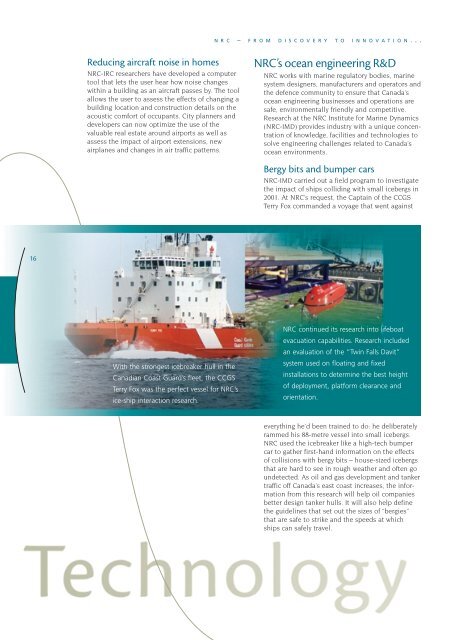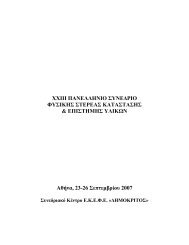NRC Annual Report 2001-2002
NRC Annual Report 2001-2002
NRC Annual Report 2001-2002
- No tags were found...
Create successful ePaper yourself
Turn your PDF publications into a flip-book with our unique Google optimized e-Paper software.
N R C – F R O M D I S C O V E R Y T O I N N O V A T I O N...Reducing aircraft noise in homes<strong>NRC</strong>-IRC researchers have developed a computertool that lets the user hear how noise changeswithin a building as an aircraft passes by. The toolallows the user to assess the effects of changing abuilding location and construction details on theacoustic comfort of occupants. City planners anddevelopers can now optimize the use of thevaluable real estate around airports as well asassess the impact of airport extensions, newairplanes and changes in air traffic patterns.<strong>NRC</strong>’s ocean engineering R&D<strong>NRC</strong> works with marine regulatory bodies, marinesystem designers, manufacturers and operators andthe defence community to ensure that Canada’socean engineering businesses and operations aresafe, environmentally friendly and competitive.Research at the <strong>NRC</strong> Institute for Marine Dynamics(<strong>NRC</strong>-IMD) provides industry with a unique concentrationof knowledge, facilities and technologies tosolve engineering challenges related to Canada’socean environments.Bergy bits and bumper cars<strong>NRC</strong>-IMD carried out a field program to investigatethe impact of ships colliding with small icebergs in<strong>2001</strong>. At <strong>NRC</strong>’s request, the Captain of the CCGSTerry Fox commanded a voyage that went against16With the strongest icebreaker hull in theCanadian Coast Guard’s fleet, the CCGSTerry Fox was the perfect vessel for <strong>NRC</strong>’sice-ship interaction research.<strong>NRC</strong> continued its research into lifeboatevacuation capabilities. Research includedan evaluation of the “Twin Falls Davit”system used on floating and fixedinstallations to determine the best heightof deployment, platform clearance andorientation.everything he’d been trained to do: he deliberatelyrammed his 88-metre vessel into small icebergs.<strong>NRC</strong> used the icebreaker like a high-tech bumpercar to gather first-hand information on the effectsof collisions with bergy bits – house-sized icebergsthat are hard to see in rough weather and often goundetected. As oil and gas development and tankertraffic off Canada’s east coast increases, the informationfrom this research will help oil companiesbetter design tanker hulls. It will also help definethe guidelines that set out the sizes of “bergies”that are safe to strike and the speeds at whichships can safely travel.
















